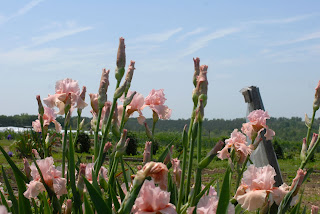The pansies had a little too much rain. Their delicate blossoms aren't terribly fond of being hosed off, so when rain splashes mud all over them, their market value quickly disappears. John cleverly solved the problem with newspaper.
Speaking of flowers, the rest of the bearded irises have bloomed. Have I mentioned how much I love them?
The lettuce patch has changed dramatically in the past few weeks. It used to look like this, but after being thinned out and soaking up the rain, its progress is quite remarkable.
The peppers are going crazy. There are blossoms everywhere and more fruit than I can count. I'm used to the customary colour progression from green to red, so I was surprised to learn that some of them start out black or brown, and turn red later. This Trinidad 7 Pot Douglah pepper has produced in a variety of colours, but the peppers will eventually be red.
There was also a Black Pearl plant, whose peppers resembled tiny eggplants. When fully ripened, they will be a shocking red. And if you need some more pepper porn, here's a cayenne:
and a Takanotsume:
Consumers are used to how things look as a finished product in the market. As a result, I was confused when John pointed out the radicchio. It didn't look at all like the small purple cone with white veins that I buy in the store. Instead, the heart of the plant forms the cone, but the outer area spreads out its leaves, much like the small bud at the center of a rose. It's really quite beautiful.
I also tried stevia, which I've only ever had in its powdered form. Marketed as a natural sweetener, it has become more common in recent years. I was completely unprepared for how cloyingly sweet the leaves were, especially since it looked just like any other herb. The sweetness lingered for several minutes after I spit it out. John will sell it both fresh and dried, and it makes a great simple syrup.
The peas clearly soaked up the rain and put all their effort into growing tall and producing pods. They had more than doubled in height in a week and a half.
We pulled sugar snap peas right off the vine and munched on them. I'm not kidding when I say I could easily chow down a pound or more of these without hesitation.
The potatoes were very happy to see an end to the drought. The straw that covers them will retain moisture very nicely, so they should develop quite rapidly over the next few weeks. Most of the action is under the straw, but we can still monitor their progress by watching the leaf structure.
Happy Rich, a less-bitter type of broccoli rabe, was ready for some early harvesting.
Formerly an obscure ingredient, it has been popping up more often in food magasines and on cooking shows. If you're like me, you sometimes end up scratching your head, trying to figure out what you can do with a vegetable you've never had. Fortunately, Kitchen Ninja has the answer. Each week, you can get advice through the CSA Share Ninja Rescue. Consider it an opportunity to find a new favourite.
And finally, the strawberries were ready.
John picked a few and offered them to me. Remember my long-standing dislike for them, I took the smallest one. Seconds later, after a loud, "Holy crap! That's delicious!", I reached for more.
I hope to bring some home with me next week, as I'm dying to try this Strawberry-Mint Sparkling Limeade from Cooking Light.
And speaking of Cooking Light, I brought home some baby bok choy, which is the star of tonight's dinner. I've made this Turkey-Jasmine Rice Meatballs with Baby Bok Choy several times, and it's always a hit.



















































